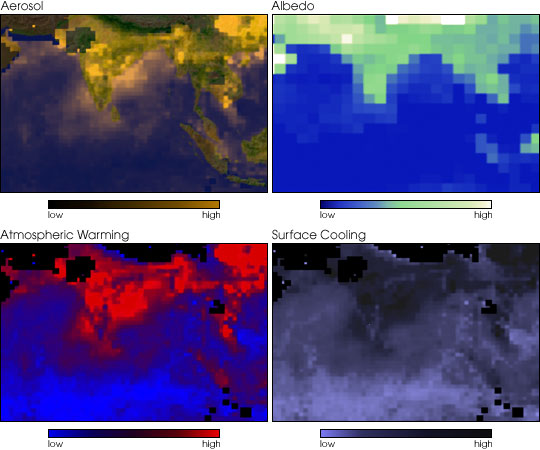


Aerosols that contain black carbon both absorb and reflect incoming sunlight. Even as these atmospheric particles reduce the amount of sunlight reaching the surface, they increase the amount of solar energy absorbed in the atmosphere, thus making it possible to both cool the surface and warm the atmosphere. The images above show satellite measurements of the region studied during the Indian Ocean Experiment (INDOEX)—a vast region spanning the Arabian Sea and Bay of Bengal (west to east), and from the foot of the Himalayan Mountains, across the Indian subcontinent to the southern Indian Ocean (north to south).
The 8-day composite image at upper left shows aerosol pollution (brownish pixels) in the lower atmosphere over the INDOEX study area, as measured by the Moderate-resolution Imaging Spectroradiometer (MODIS) aboard Terra. These data were composited from March 14-21, 2001.
The upper right image shows the total solar energy reflected back to space, as measured by the Clouds and Earth's Radiant Energy System (CERES) aboard Terra. White pixels show high values, greens are intermediate values, and blues are low. Note how the aerosols, particularly over the ocean, increase the amount of energy reflected back to space.
The lower left image shows the absorption of the black carbon aerosols in the atmosphere. Where the aerosols are most dense, the absorption is highest. Red pixels indicate the highest levels of absorption, blues are low.
The lower right image shows that the aerosol particles reduce the amount of sunlight reaching the surface. Dark pixels show where the aerosols exert their cooling influence on the surface (or a high magnitude of negative radiative forcing). The bright pixels show where there is much less aerosol pollution and the incoming sunlight is relatively unaffected.
For more information, animations, and high-resolution images, read New NASA Satellite Sensor and Field Experiment Shows Aerosols Cool the Surface but Warm the Atmosphere.
Images and animations by Tom Bridgman, NASA GSFC Science Visualization Studio; Data courtesy Terra CERES and MODIS Science Teams, NASA LaRC and GSFC, and Scripps Institution of Oceanography